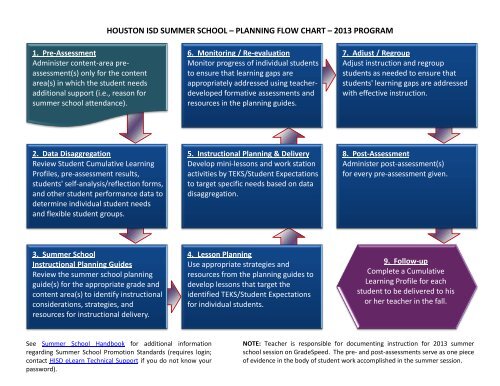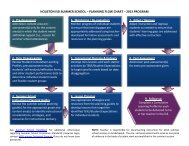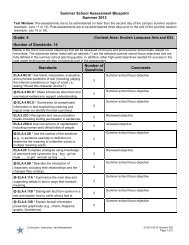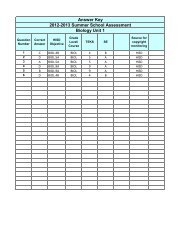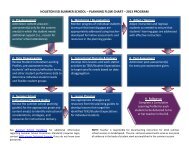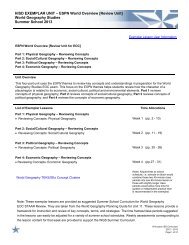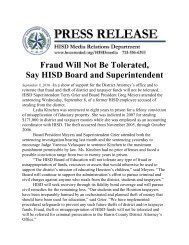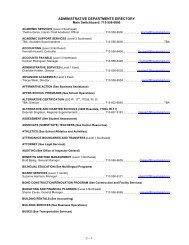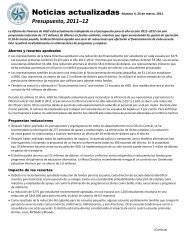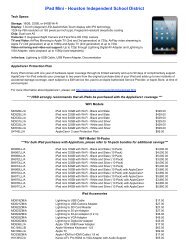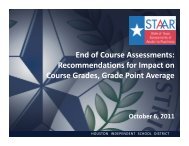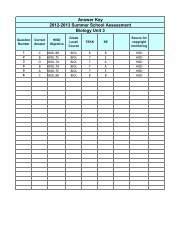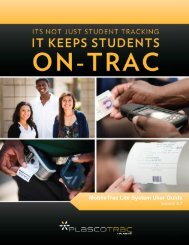HOUSTON ISD SUMMER SCHOOL â PLANNING FLOW CHART ...
HOUSTON ISD SUMMER SCHOOL â PLANNING FLOW CHART ...
HOUSTON ISD SUMMER SCHOOL â PLANNING FLOW CHART ...
Create successful ePaper yourself
Turn your PDF publications into a flip-book with our unique Google optimized e-Paper software.
<strong>HOUSTON</strong> <strong>ISD</strong> <strong>SUMMER</strong> <strong>SCHOOL</strong> – <strong>PLANNING</strong> <strong>FLOW</strong> <strong>CHART</strong> – 2013 PROGRAM1. Pre-AssessmentAdminister content-area preassessment(s)only for the contentarea(s) in which the student needsadditional support (i.e., reason forsummer school attendance).6. Monitoring / Re-evaluationMonitor progress of individual studentsto ensure that learning gaps areappropriately addressed using teacherdevelopedformative assessments andresources in the planning guides.7. Adjust / RegroupAdjust instruction and regroupstudents as needed to ensure thatstudents' learning gaps are addressedwith effective instruction.2. Data DisaggregationReview Student Cumulative LearningProfiles, pre-assessment results,students' self-analysis/reflection forms,and other student performance data todetermine individual student needsand flexible student groups.5. Instructional Planning & DeliveryDevelop mini-lessons and work stationactivities by TEKS/Student Expectationsto target specific needs based on datadisaggregation.8. Post-AssessmentAdminister post-assessment(s)for every pre-assessment given.3. Summer SchoolInstructional Planning GuidesReview the summer school planningguide(s) for the appropriate grade andcontent area(s) to identify instructionalconsiderations, strategies, andresources for instructional delivery.4. Lesson PlanningUse appropriate strategies andresources from the planning guides todevelop lessons that target theidentified TEKS/Student Expectationsfor individual students.9. Follow-upComplete a CumulativeLearning Profile for eachstudent to be delivered to hisor her teacher in the fall.See Summer School Handbook for additional informationregarding Summer School Promotion Standards (requires login;contact H<strong>ISD</strong> eLearn Technical Support if you do not know yourpassword).NOTE: Teacher is responsible for documenting instruction for 2013 summerschool session on GradeSpeed. The pre- and post-assessments serve as one pieceof evidence in the body of student work accomplished in the summer session.
Daily Reading/Language Arts Lesson Plan Time Allotment RecommendationsGrades 3-5 (Full Day)Time Format Activity / Resources20minutesWhole GroupTeacher Read-AloudClassroom or campus library; excerpts from Reading Street/Tesoros15minutes20minutes30minutes90minutesWhole GroupWhole Group,Small Group, or PartnersWhole GroupSmall GroupAdvanced PhonicsTPRI/Tejas Lee Intervention Activities GuideFlorida Center for Reading Research(FCRR) website activitiesIstationNeuhaus MaterialsVocabulary / Oral Language DevelopmentReading Street/Tesoros materials and resourcesIstationComprehension Skills (skill-based mini-lessons)Use leveled readers to teach skills (Reading Street/Tesoros)IstationWorkstationsInstructional activities based on advanced phonics, fluency, vocabulary,comprehension, and writingWorkstation materials (Reading Street/Tesoros)Florida Center for Reading Research (FCRR) website activitiesTeacher Directed Small Group Instruction: leveled readers for guidedreading (Reading Street/Tesoros)Istation and Neuhaus Materials15 minutes Whole Group Teacher Read-AloudClassroom or campus library; excerpts from Reading Street/Tesoros60minutesWhole Group,Small Group,Individual,or PartnersWritingMentor text and mini- lesson to highlight specific writing traits within thewriting process (6+1Traits Writing)60 minutes Individual, Small Group,or PartnersIndependent Reading/JournalWriting/SharingClassroom and campus libraryLeveled reader database (Reading Street/Tesoros)Writing Journals20minutes15minutesPartners orSmall GroupWhole GroupBuilding FluencyTimed Partner ReadingsReader’s Theatre practiceLeveled reader database (Reading Street/Tesoros)**Monday “Fresh” read; practice all week; Thursday assessmentTeacher Read-AloudClassroom or campus library; excerpts from Reading Street/TesorosNotes:*This schedule is for a 6 hour and 15 minute day.**It is recommended that Tier II and Tier III (My Sidewalks) Intervention resources are used to support theinstructional needs of the individual students. Teacher editions provide notes for intervention.**Bilingual classes must plan to deliver English instruction a minimum of 30% of the school day (i.e.,during teacher read-aloud, work stations, small group, etc.).© Houston <strong>ISD</strong> Curriculum2012-2013Page 2 of 2
English Language Arts and ESL Component – Grade 3Summer School Curriculum Planning GuideSummer Session Learning Focus: Students will review and extend key standards and concepts to ensure readiness for future learning.Key Concepts:• Narrative Text • Expository Text • Short story • Oral Language Development • VocabularyKey Skills:• Make Connections• Author’s Purpose• Text StructureOral LanguageH<strong>ISD</strong> ObjectivesIn order to teach this standard in depth,use the Unpacking the Standarddocument.ELA.3.31AParticipate in teacher- and student-leddiscussions by posing and answeringquestions with appropriate detail and byproviding suggestions that build upon theideas of others.ELPS 3(C-J)Time Allocation20 DaysTeachers mustplan to addressindividual studentneeds based ondata frompreviouslyadministeredassessments(TPRI/Tejas Lee,iStation, HFWE,Benchmarks,etc.). In addition,the summerschool preassessment,iStation, and anyother campusbasedassessmentsshould be utilizedto driveindividualizedinstruction.• Story Elements• Questions• ConclusionsAssessmentConnectionsTexas EnglishLanguageProficiencyAssessmentSystem(TELPAS)EducatorGuide toTELPASUse theexcELLenceLiteracy routineDo I Really GetIt? to check forunderstanding• Inferences• Summarization• Capitalization• Punctuation• Synonyms• Antonyms• Prefixes• SuffixesInstructional Considerations Instructional Strategies ResourcesEssential Understanding Guiding QuestionsDifferent cultures have similarities.1. How are cultures alike and different?2. What do you think people from all cultures have incommon?Prerequisites/Background Knowledge for StudentsThe student should have prior experience in establishingpurpose for reading a variety of genres and formats.Background Knowledge for TeacherStudents should be given practice in posing and answeringquestions to guide reading and class discussion. Use thefollowing example from Annenberg VIDEO SupportingELL’s with lesson plans and printouts.Summarization and Note TakingKWLActivate prior knowledge with the KWL chart; at thebeginning of the lesson and ask students to write whatthey know about each topic, what they want to know,and then at the end of each lesson students will writewhat they have learned. Ask them to work in groups todiscuss their learning.What I knowWhat I wantto knowWhat IlearnedRead AloudBuild in multiple opportunities throughout the day for classread alouds. Suggested literature:• Read Across America 2013 Booklist EC-Adult• GoodReads List of Read Alouds• Teacher Suggestions 3-5Reading StreetUnit 5 Week 1CulturesUse ResponseSignals as a quick andinformative non-verbalstrategy to check forstudentunderstanding. - English Language Proficiency Standards (ELPS)- Literacy Leads the Way Best Practices- Aligned to Upcoming State Readiness Standard R - State Readiness Standard S - State Supporting Standard© Houston <strong>ISD</strong> – Curriculum2012 – 2013Page 1 of 27
English Language Arts and ESL Component – Grade 3Summer School Curriculum Planning GuideH<strong>ISD</strong> ObjectivesTime AllocationAssessmentConnectionsInstructional Considerations Instructional Strategies ResourcesProvide practice discussing changes in meaning caused bythe affix added to the original meaning of the word.Review complex inflectional endings (such as –ed, -e/s, -ing) and common prefix and suffix morphemes such as – ly(e.g.: lately), -ness (e.g., happiness) –tion (e.g.,syllabication) and –sion (e.g., tension). Introduce prefixes,suffixes, and roots such as –able, -ible, -ist, di-, etc. It’s bestto organize word study around a common root (Allen, 1999)once prefixes and suffixes are recognized in the form offamilies of words (Johnson, 1991).Assessment ConsiderationsQuestion Stems3.4A Prefixes/SuffixesIf this word means ____, what would this same word meanwith (un-, dis-, etc.) in front of it?If this word means ____, what would this same word meanwith (-ful, -less, etc.) at the end?3.4B ContextIn paragraph __ of this story, what does the word ____mean?What clues helped you know the meaning of the word____?In paragraph __ of this newspaper article, what clueshelped you know the meaning of ____?3.4CAntonyms/SynonymsWhat word has the same meaning as ______?What word in paragraph ____ means the opposite of ____?BaseWordhappyPrefix Word Meaningun-unhappynot happyplay re- replay play againBaseSuffix Word MeaningWordcheer -ful cheerful full of cheersleeples not able tosleep -lesss sleepin a slowslow -ly slowlywayHave students create new derivatives from the samelinguistic root in English. Practice their spelling with the useof flashcards, concentration games, spelling relays, etc.Prefix Root Suffix Derivative Meaningkind -ly kindlyun kind unkindlike -able likeabledis like- dislikeplay -ful playfulre play replayContextVocabulary StrategiesTeach the concept of context clues to determine wordmeaning. First, look at the structure of the word. Can it beidentified by using the prefix, base word, or suffix? Next,determine if the unfamiliar word is followed by the definition(apposition) which is followed by a comma. Last, look forwords in the sentence or paragraph to figure out the word.Use the visual aid below to help students remember thesteps to use context clues to determine an unfamiliar word. - English Language Proficiency Standards (ELPS)- Literacy Leads the Way Best Practices- Aligned to Upcoming State Readiness Standard R - State Readiness Standard S - State Supporting Standard© Houston <strong>ISD</strong> – Curriculum2012 – 2013Page 3 of 27
English Language Arts and ESL Component – Grade 3Summer School Curriculum Planning GuideH<strong>ISD</strong> ObjectivesTime AllocationAssessmentConnectionsInstructional Considerations Instructional Strategies ResourcesDictionary UseReview dictionary skills. Provide dictionaries to find thecorrect spelling and meaning of multiple meaning words.Guide students in examining dictionary entries and thecontext in which the word is found in text to determine themost appropriate meaning. Dictionary.com ElectronicDictionaryTrade Book LessonUse the following lesson to model how to determine themeaning of unfamiliar words. The author uses made-upwords for common words. Students use context to determinethe meaning.Lesson Plan for Context Clues using Henry P. Baloney byJon Scieszka (This book can be found in most schoollibraries.)Synonyms/AntonymsIdentifying Similarities and DifferencesFrayer ModelUse a modified version of the Frayer Model to illustratesynonyms and antonyms of a word. Encourage studentsto create their own models with words they may havefound interesting in the texts read, and to use the wordswhen speaking or writing.ExamplestoryNon-ExamplepoemDefinitionText not based infactFictionIllustrationNonlinguistic RepresentationGraphic OrganizerProvide students with definitions. Ask students to write theword that corresponds to the definition, and then askstudents to write sentences with these words. Practice thevocabulary of the week with this activity. Have studentswork in pairs, with a list of words. Students will look forsynonyms and antonyms using a dictionary for this activity,and then share their words with the group. - English Language Proficiency Standards (ELPS)- Literacy Leads the Way Best Practices- Aligned to Upcoming State Readiness Standard R - State Readiness Standard S - State Supporting Standard© Houston <strong>ISD</strong> – Curriculum2012 – 2013Page 4 of 27
English Language Arts and ESL Component – Grade 3Summer School Curriculum Planning GuideKey Concepts:• FluencyKey Skills:• Rate • Accuracy • Expression • Appropriate Phrasing • ComprehensionH<strong>ISD</strong> ObjectivesFluency and Independent ReadingIn order to teach these standards indepth, use the Unpacking the Standarddocument.ELA.3.3A Read aloud grade level textwith fluency (rate, accuracy, expression,appropriate phrasing) andcomprehensionELPS 4(A-C, E, H)ELA.3.11ARead independently for a sustainedperiod of time and paraphrase what thereading was about, maintaining meaningand logical order (e.g., generate areading log or journal; participate in booktalks).ELPS 4(G)TimeAllocation*Followprotocol statedon page 1.AssessmentConnectionsTrack fluency rateusing a fluencytracking graphsuch asBlackline Masterfor BuddyReading-Accuracy,Prosody, SpeedInstructional Considerations Instructional Strategies ResourcesPrerequisites/Background Knowledge for StudentsStudents should decode words; read 3 rd grade vocabularywords with 90 - 100% accuracy; and read at least 90-120words per minute.Background Knowledge for TeachersThe focus of this cluster of objectives is the development ofreading fluency.Begin by establishing a benchmark from which to setpersonal goals for students in accuracy and reading rate.Use the recommended fluency probes available in ReadingStreet or any other monitoring tool.Use available data to plan intervention activities. Studentsdemonstrating difficulty meeting the end of year measurefor 3 rd grade (120 WCPM) or those who are non-readersshould be provided on-going, focused, individualized orsmall group intervention through direct instruction.Structure opportunities for students to engage in both oraland silent reading. Oral reading helps develop rate,accuracy, expression, and appropriate phrasing, while silentreading builds reading stamina.Reading Materials: You can use the following resourcesfor reading materials for your students or your ownclassroom library.• Reading Street Leveled Readers• Selections from the student edition of Reading Street• Newspapers, magazines, internet resourcesSetting Objectives and Providing Feedback1. Poll students’ interests to create a Library Work Stationwith a variety of grade appropriate and high interestbooks for students to explore. Include leveled readersin the Library Work Station. Use the Leveled ReaderSkills Chart in Reading Street Guide on the Side toidentify appropriate selections based on student needs.Guide students in selecting appropriate readingmaterials according to their corresponding independentreading level.2. Adjust your daily schedule to provide at least a fifteenminute daily opportunity for independent readingpractice. Try to schedule the sustained silent readingperiod at the same time every day to establish a readingroutine; this will help prepare students for district andstate mandated reading assessments that requirereading stamina.Two keys to increasing student reading fluency are tomodel fluency and provide students plenty of time forrepeated readings of texts.Tip for Modeling Accuracy:Choose a nonfiction selection that students have read.Have them follow along as you read. Say:I will read every word in this passage without leaving anywords out or substituting any words. If I change a word orleave one out, I might change the meaning.Fluency skills are: accuracy, rate, characterization,phrasing, commas, expression, intonation, punctuation,silent reading, and self-correction.5-Day Fluency Plan:1. Model fluent reading using text of your choicefocusing on fluency skill of the week.2. Echo Reading or Choral Reading. Same as Day 1,but then practice as a class by doing three echoreadings or choral readings of each paragraph.3. Model the skill again using a different passage fromtext. Then practice as a class doing three echo orchoral readings. - English Language Proficiency Standards (ELPS)- Literacy Leads the Way Best Practices- Aligned to Upcoming State Readiness Standard R - State Readiness Standard S - State Supporting StandardModel the use of a reading fluency log; ask students todocument their independent reading progress as they worktoward reaching or surpassing the fluency goal establishedfor third grade, 120+.Setting Objectives and Providing FeedbackText WalkConduct a series of quick text walks to motivate students toread books they would not generally choose to read.Showcase books in the reading Work Station associatedwith themes being developed in specific content areas.Setting Objectives and Providing Feedback1. Monitor reading fluency using fluency probes. Use therecommended fluency probes available in ReadingStreet or any other monitoring tool. Use the results toprovide individual students with intervention oracceleration in any or all of the following elements offluency: accuracy – the ability to recognize and/or decode wordscorrectly. rate – how quickly and accurately one reads connectedtext. Rate is measured as the number of words readcorrectly per minute (WCPM – words correct per minute) automaticity – the quick and effortless reading of words,© Houston <strong>ISD</strong> – Curriculum2012 – 2013Page 5 of 27
English Language Arts and ESL Component – Grade 3Summer School Curriculum Planning GuideH<strong>ISD</strong> ObjectivesTimeAllocationAssessmentConnectionsInstructional Considerations Instructional Strategies Resources4. Partner Reading - Partners practice reading aloudsame passage that was modeled on Day 3. Studentsshould read emphasizing the skill and offer eachother feedback.5. Assess Individual Reading Rate. Take a one-minutesample of a student’s oral reading. Pay attention tothe week’s fluency skill. Provide feedback.Refer to Reading Street Guide on the Side for strategies,activities, and suggestions for teaching fluency.whether in or out of context, and/or prosody – reading with expression2. Provide example and non examples of reading todevelop self awareness of reading with fluency. Nonexamples include “robot reading”, “stop-and-goreading”, “monotone reading or reading withoutprosody”, or “slow-reading”. Guide making comparisonsbetween reading in these ways and reading fluently.Nonlinguistic RepresentationSetting Objectives and Providing Feedback• Read aloud to students daily to model prosody.• Motivate students to read books they would normallynot read through text walks.• Provide daily opportunities for independent readingincluding sustained-silent reading.• Make accessible a variety of grade appropriate andmulti-level reading material (fiction and nonfiction).Use a variety of grouping strategies including ChoralReading, Echo Reading, Partner Reading, IndependentReading, etc. to develop reading fluency.Shared Reading, Shared WritingProvide opportunities for students to improve their accuracyin decoding words or recognizing sight words throughshared reading and writing activities.Blackline Master for BuddyReading-Accuracy, Prosody,SpeedCooperative Learning Think-Aloud• Model how fluent readers use intonation, rate andprosody to enhance comprehension during read-aloudsor shared reading.• Use a Think-Aloud to invite students to take notice ofthe choices you made in intonation, rate and prosody.• Have students imitate your intonation, rate or prosodythrough echo or choral reading.Use Reader’s Theatre to promote reading comprehensionand fluency. In reader’s theater, students read text alouddramatically to an audience. There are minimal or noprops. One student narrator reads the descriptive parts, anddifferent students read the part of each character. Textschosen should not be above the students’ instructionallevel. Students should choose or be assigned parts in whichthey can be successful. After several rehearsals (repeatedreadings), the reading is presented to an audience.Use Fluency activities from FCRR to develop and practicephrasing, expression, and rate. See Resource Column.Reader’s Theatre WebsiteResources:• Reader’s Theatre• Storycart Reader'sTheater Scripts• The Reading LadyReader's Theater Scripts• Reading Street Reader'sTheater Anthology• Reader’s Theatre• Reader’s Theater in Englishand SpanishFCRR Resources:Fluency- PhrasingFluency- Phrasing,Intonation, Expression,Accuracy - English Language Proficiency Standards (ELPS)- Literacy Leads the Way Best Practices- Aligned to Upcoming State Readiness Standard R - State Readiness Standard S - State Supporting Standard© Houston <strong>ISD</strong> – Curriculum2012 – 2013Page 6 of 27
English Language Arts and ESL Component – Grade 3Summer School Curriculum Planning GuideSummer Session Learning Focus: Students will review and extend key standards and concepts to ensure readiness for future learning.Key Concepts:• Narrative Text • Expository Text • Short story • Oral Language Development • VocabularyKey Skills:• Make Connections• Author’s Purpose• Text StructureH<strong>ISD</strong> ObjectivesComprehension: Narrative TextIn order to teach these standards in depth,use the Unpacking the Standard document.ELA.3.5BCompare and contrast the settings in mythsand traditional folktales (and other genres,and identify its importance to the story).ELPS 4(J,K), 5(G)R ELA.3.8ASequence and/or summarize the plot's mainevents (including conflict) and explain theirinfluence on future events.ELPS 3(G-J)R ELA.3.8BDescribe the interaction of charactersincluding their relationships and thechanges they undergo.ELPS 3(G-J)• Story Elements• Questions• ConclusionsTime Allocation*Follow protocolstated on page 1• Inferences• Summarization• Capitalization• PunctuationAssessmentConnectionsIn order to guideinstructionaldecisions ingrades K-5,teachers shouldadminister the 30minute iStationISIP assessmentto all students.Tracking StudentGrowth andProgressOut of Right Field -Plot- Sequence ofEventsAssessmentUse theexcELLenceLiteracy routineDo I Really GetIt? to check forunderstandingConsider using exittickets to check forunderstanding• Synonyms• Antonyms• Prefixes• Suffixes• Make Connections• Author’s Purpose• Text StructureInstructional Considerations Instructional Strategies ResourcesIstation Reading Intervention is an instructional tool that canbe used during workstations to meet individual studentneeds.Compare and Contrast SettingsPrerequisites/Background Knowledge for StudentsThe student should have previous knowledge of compareand contrast.Background Knowledge for TeacherThe focus of this cluster of objectives is comparing andcontrasting, and making connections between literary andinformational texts. Development of these skills is in theRead and Comprehend section of Reading Street.Focus on making inferences and drawing conclusions bytaking into account text structure and text features. Modelwith a Think-Aloud, visuals, and real experiences.Use guiding questions to guide students’ critical readingand analysis of specific text elements such as plot, conflict,climax, resolution, etc:What happened here in the story?Was this an important event? Why or why not?How did this event affect the character? How did thecharacter change?How did this event affect the plot or direction of the story?Did events have anything to do with the conflict? How so?What is this paragraph/passage mainly about?Assessment ConsiderationsQuestion Stem3.5BCompare and ContrastHow were ____ and ____ alike/different?How are the settings of these two myths alike?Text Connections Background OverviewYou may login to www.istation.com to access specificinstructional strategies to meet the needs of all students.Reading Materials: You can use the following resourcesfor reading materials for your students or your ownclassroom library.• Reading Street Leveled Readers• Selections from the student edition of Reading Street• Newspapers, magazines, internet resourcesCompare and Contrast SettingsNonlinguistic RepresentationGraphic OrganizerHave students use a graphic organizer to compare andcontrast the settings in a variety of fictional text, drawingconclusions from the facts presented with textual evidence.Term 1 Term 2Identifying Similarities and Differences/ NonlinguisticRepresentationsHave students use a triple Venn Diagram or chart todiscuss, compare and contrast main elements of narrativeand expository texts.Cues, Questions, and Advanced OrganizersHave students make connections with the text throughquestioning. Model asking and responding to probingquestions such as:Provide guiding questions for students. Ask questionsfocusing on the setting:‣ What thing/s from the setting are familiar to you? Howwould you describe the setting?‣ Would you like to live in that place? Why (not)?‣ Why is the setting important? Where and when does theaction take place?‣ How would the plot change if the setting were different?‣ How is the setting important? How does it contribute tothe problem faced by the character?Annenberg VIDEOBuildingComprehension withlesson plans.Effective PracticesLinkAmerican Folklore: Ajigsaw characterstudy-lesson andactivitiesUser ResponseSignals as a quick andinformative non-verbalstrategy to check forstudentunderstanding.Exit Tickets - English Language Proficiency Standards (ELPS)- Literacy Leads the Way Best Practices- Aligned to Upcoming State Readiness Standard R - State Readiness Standard S - State Supporting Standard© Houston <strong>ISD</strong> – Curriculum2012 – 2013Page 7 of 27
English Language Arts and ESL Component – Grade 3Summer School Curriculum Planning GuideH<strong>ISD</strong> ObjectivesTime AllocationAssessmentConnectionsInstructional Considerations Instructional Strategies ResourcesAsk questions focusing on the problem/conflict:‣ What is the conflict? Is it similar to one in your own life?‣ How do you think this problem has to be solved? Why?‣ Think about the way the character has tried to solve hisproblem: what does the author want for you to learn fromthis? (base your reasoning on text evidence)Ask questions focusing on plot events:‣ Does this story remind you of something else? What hashappened to you in life similar to this?‣ What do you think it is going to happen next and why?‣ How do you feel? What has the author done to createthat feeling? (support your argument with text evidence)‣ What events were the most important and why? Why doyou think the author included those scenes?Cooperative LearningGraphic OrganizerHave students use graphic organizers to work incooperative groups to compare and contrastcharacters, events, texts, and stories.Compare/ContrastX and Y are similar because……but X... while Y…and ...Use the interactive Venn Diagram for whole class review ofCompare and Contrast from ReadWriteThink.Identifying Similarities and Differences/ NonlinguisticRepresentationsGraphic OrganizerHave students use a triple Venn Diagram or chart todiscuss, compare and contrast main elements of narrativeand expository texts.Have students review and discuss main characteristicsand elements, as they complete a chart:FÁBLES FOLKTALES MYTHSCompare (similarities)Oral retelling ExhibitculturalvaluesExplain naturaleventsHave amoral toteachlessonContrast (differences)Always end The protagonistswellare gods andheroes - English Language Proficiency Standards (ELPS)- Literacy Leads the Way Best Practices- Aligned to Upcoming State Readiness Standard R - State Readiness Standard S - State Supporting Standard© Houston <strong>ISD</strong> – Curriculum2012 – 2013Page 8 of 27
English Language Arts and ESL Component – Grade 3Summer School Curriculum Planning GuideH<strong>ISD</strong> ObjectivesTime AllocationAssessmentConnectionsInstructional Considerations Instructional Strategies ResourcesIdentifying Similarities and Differences/ NonlinguisticRepresentationsGraphic OrganizerHave students use a Graphic Organizer to makeconnections between and across multiple texts ofvarious genres and provide textual evidence.Comparing Folk literature storiesTitle Fable Tall TaleCharactersSettingConflictMain eventsResolutionTheme / lessonSequence and Summarize Plot EventsPrerequisites/Background Knowledge for StudentsThe student should have previous knowledge of sequenceand be able to summarize the plot’s main events.Background Knowledge for TeacherThe focus of this cluster of objectives is to summarize theinformation in the text using text evidence. Development ofthese skills is in the Read and Comprehend section ofReading Street.Explain that it is important to know the order or sequencethat events take place in a story. Through Read-Aloudsshow students how to look for signal words like first, next,last, before, after and finally to help them figure out thesequence.Model through a Think-Aloud how to summarize a storybefore, during, and after reading, using signal words, e.g.before, after, then, at the beginning, at the end, etc.Assessment ConsiderationsQuestion Stem3.8ASequenceWhat happened when_____?Before_______did________, what did he do?Why is paragraph _____ important in this story?Sequence and Summarize Plot EventsNonlinguistic RepresentationThink-Pair-Share Think-AloudHave students work in pairs to predict and summarize thestory events by looking at the illustrations, title, headings,bold print, etc.Setting ObjectivesThrough Read-Aloud, guide students to identify thesequence of the story. Explain that sequence is theorder in which events occur in the story; some key wordssuch as before, after, and last can tell when thingsoccur.Graphic OrganizerUse the Sequence and Summarization chart to assiststudents in identifying the beginning, middle and endingof a passage. First, have students identify the beginning,middle, and ending of the story. Next, students shouldsummarize each part of the story with one or two eventsfrom each section. - English Language Proficiency Standards (ELPS)- Literacy Leads the Way Best Practices- Aligned to Upcoming State Readiness Standard R - State Readiness Standard S - State Supporting Standard© Houston <strong>ISD</strong> – Curriculum2012 – 2013Page 9 of 27
English Language Arts and ESL Component – Grade 3Summer School Curriculum Planning GuideH<strong>ISD</strong> ObjectivesTime AllocationAssessmentConnectionsInstructional Considerations Instructional Strategies ResourcesSomebody Wanted But SoUse this chart to organize a summary of a short story. TheSomebody section is who the main character is. Wanted iswhat the main character wants. But is the conflict within thestory and the So is the resolution of the conflict.Somebodythe big bad wolfButthey hid in the brickhouseWantedpigs for dinnerSohe went hungry.Use Summary Frames to help scaffold students insummarizing texts.CharactersPrerequisites/Background Knowledge for StudentsThe student should have previous knowledge of narrativetext elements in stories.Background Knowledge for TeacherThe focus of this objective is to describe the interaction ofcharacters including their relationships using text evidence.Development of these skills is in the Read andComprehend Section of Reading Street.Through Read-Aloud, help students to identify thecharacters and discuss their type and their attributes.Remind students that attributes refer to the physical andemotional qualities that a character possesses, similar tothose that real people have.Review the elements of narrative text such as characters,cause and effect, setting, conflict, plot or theme, focusingon: understanding a character’s personality by noticing heractions, speech, and interactions with the conflict and othercharacters.Use guiding questions to guide students’ critical reading andanalysis of specific text elements such as plot, conflict,climax, resolution, etc:• What happened here in the story?Use the Story Summary Cube Student Interactive from Refer to ReadingReadWriteThink to summarize the key story elements. Street Unit 1, Week 1Story Cube: In this cube option, students can summarize the to help developkey elements in a story, including character, setting, conflict, objective: Character.resolution, and theme. Students can even identify their favoritepart of the story. This can be used as analternative to the Story Map interactive.CharactersCues, Questions, and Advanced OrganizersTo introduce key phrases, use examples from a familiartext or situation to activate prior knowledge.Use The Three Little Pigs or another story to modelcharacter traits. Complete the Character Traits andEvidence Graphic Organizer Chart. Use the Big Bad Wolfas the character of focus. Provide evidence to prove thatthe Big Bad Wolf is truly bad and scary.CharacterTraitdark brownand furrylikes to eatporkEvidencehave seen pictures of theBig Bad WolfHe wanted to eat the 3 littlepigs and pigs are pork. - English Language Proficiency Standards (ELPS)- Literacy Leads the Way Best Practices- Aligned to Upcoming State Readiness Standard R - State Readiness Standard S - State Supporting Standard© Houston <strong>ISD</strong> – Curriculum2012 – 2013Page 10 of 27
English Language Arts and ESL Component – Grade 3Summer School Curriculum Planning GuideH<strong>ISD</strong> ObjectivesTime AllocationAssessmentConnectionsInstructional Considerations Instructional Strategies Resources• Was this an important event? Why or why not?• How did this event affect the character? How did thecharacter change?• How did this event affect the plot or direction of the story?• Did events have anything to do with the conflict? How so?• What is this paragraph/passage mainly about?Assessment ConsiderationsQuestion Stem3.8BCharactersWhat can you tell about___and _____?How did _____feel about____?How did____ feel about_____ at the end of the story?meanHe tries to eat the pigs bydestroying their homes.Cooperative LearningThink-Pair-Share• Divide students into pairs and ask each student to thinkabout the characters in the text and take turns sharingtheir opinions using text evidence to substantiate theircomments.• Then, ask each student pair to select one characterfrom the story and write descriptive sentences about thecharacter.• Later, have a reporter from the group read thedescription to the class; ask students to identify thesecret character based on the description given.• Debrief results with the class; focus on the charactertraits presented that helped them identify the character.Summarizing and Note TakingGraphic OrganizerIn order to target a character’s physical traits, feelings,behaviors, motives, the relationships they have with othercharacters, and their problem solving strategies, use thefollowing content frames: How we learn about a characterCharacter nameWhat character saysWhat character doesWhat character thinksWhat others say about characterWhat others think about characterHow the character interacts with others Comparing charactersCharacter nameConflictQualities valuedReward earned Comparing storiesTitleCharactersSetting - English Language Proficiency Standards (ELPS)- Literacy Leads the Way Best Practices- Aligned to Upcoming State Readiness Standard R - State Readiness Standard S - State Supporting Standard© Houston <strong>ISD</strong> – Curriculum2012 – 2013Page 11 of 27
English Language Arts and ESL Component – Grade 3Summer School Curriculum Planning GuideSummer Session Learning Focus: Students will review and extend key standards and concepts to ensure readiness for future learning.Key Concepts:• Narrative Text • Expository Text • Short story • Oral Language Development • VocabularyKey Skills:• Make Connections• Author’s Purpose• Text StructureH<strong>ISD</strong> ObjectivesComprehension: Expository TextIn order to teach these standards in depth,use the Unpacking the Standard document.ELA.3.12AIdentify the topic and locate the author'sstated purposes in writing the text.ELPS 3(H), 4((J,K)R ELA.3.13AIdentify the main idea and details or factsthat support the main idea.ELPS 4(I)R ELA.3.13BDraw conclusions from the facts presentedin text and support those assertions withtextual evidence.ELPS 2(G,H), 4(J) • Story Elements• Questions• ConclusionsTime Allocation*Follow protocolstated on page 1• Inferences• Summarization• Capitalization• PunctuationAssessmentConnectionsIn order to guideinstructionaldecisions ingrades K-5,teachers shouldadminister the 30minute iStationISIP assessmentto all students.The Cougar - MainIdea and DetailsAssessmentUse theexcELLenceLiteracy routineDo I Really GetIt? to check forunderstandingConsider using exittickets to check forunderstanding• Synonyms• Antonyms• Prefixes• Suffixes• Make Connections• Author’s Purpose• Text StructureInstructional Considerations Instructional Strategies ResourcesIstation Reading Intervention is an instructional tool that canbe used during workstations to meet individual studentneeds.Topic/Author’s PurposeBackground Knowledge for TeacherThe focus of this cluster of objectives is that studentsdevelop a purpose for reading, participate in discussionsand oral retell employing the correct conventions of oralwrittencommunication. Identify the topic and locate theauthor’s stated purpose in writing the text. Development ofthese skills is in the Read and Comprehend section ofReading Street.Explain that establishing a purpose for reading helps tokeep the readers’ attention focused on key elements.Setting a purpose for reading generally occurs during prereading,and involves posing questions, using GraphicOrganizers, establishing personal goals, etc. Ensure thatstudents read a variety of genres.You may login to www.istation.com to access specificinstructional strategies to meet the needs of all students.Topic/Author’s PurposeReading Materials: You can use the following resourcesfor reading materials for your students or your ownclassroom library.• Reading Street Leveled Readers• Selections from the student edition of Reading Street• Newspapers, magazines, internet resourcesNonlinguistic RepresentationGraphic OrganizerRead aloud different expository mentor texts and havestudents discuss the writer’s purpose based upon textevidence. Have students classify texts. Post and discussexamples in a whole-class format.PURPOSE TITLE TEXTUALEVIDENCEInformSolve ProblemsReflectOtherFor additional graphic organizers, use Scholastic GraphicOrganizers for Identifying Author’s purposeGenerating and Testing HypothesesThink-AloudUsing a Think-Aloud, teach the students how to identify thetopic and locate the author's stated purposes in writing thetext. Discuss ways the author tries to persuade the reader.Author’s Purpose Visual Graphic OrganizerUse Author’s Purpose Pie to teach and practicecategorizing various pieces of text into 4 primary purposes:Persuade, entertain, share, informReading StreetUnit 5 Week 1CulturesRefer toReading StreetUnit 2 Week 1 to helpdevelop the objectives:Main Idea andSummarize.Effective Practices Link - English Language Proficiency Standards (ELPS)- Literacy Leads the Way Best Practices- Aligned to Upcoming State Readiness Standard R - State Readiness Standard S - State Supporting Standard© Houston <strong>ISD</strong> – Curriculum2012 – 2013Page 13 of 27
English Language Arts and ESL Component – Grade 3Summer School Curriculum Planning GuideH<strong>ISD</strong> ObjectivesTime AllocationAssessmentConnectionsInstructional Considerations Instructional Strategies ResourcesNonlinguistic RepresentationGraphic OrganizerRead aloud different expository mentor texts and havestudents discuss the writer’s purpose based upon textevidence. Have students classify texts. Post and discussexamples in a whole-class format.Use the pie graphic to help students remember and identifyvarious authors’ purposes. Author’s Purpose PieMain Idea/DetailsPrerequisites/Background Knowledge for StudentsThe student should be familiar with narrative text main ideaand supporting details.Background Knowledge for TeacherThe focus of this cluster of objectives is to show studentshow to identify and determine main ideas and salient detailsin expository and narrative texts. Development of theseskills is in the Read and Comprehend section of ReadingStreet.Use Read-Alouds to guide students to identify the mainidea and details or facts that support the main idea. Providepractice by having students identify the best main idea fromamong statements that express possible main idea. Oneway to do this is by asking individual students to articulate amain idea statement for a passage or selection read. Scriptthese on the board or on sentence strips, and have theclass select the most appropriate main idea.Through Reciprocal Teaching (structured dialogue) guidestudents to identify main idea and details. Use this strategyto aid students in constructing meaning from text; and tomonitor their reading to ensure that they are inunderstanding what they read.Main Idea/DetailsSummarizing and Note TakingTwo-Column Notes1. Use Two-Column Notes to document main idea/ detailsfrom texts read.Main IdeasDetailsTo extend this activity, provide students with a series ofmain idea statements and a series of details. Ask studentsto determine if the details support the main idea, or areirrelevant.Think-AloudTeach students to paraphrase expository text. Use a Think-Aloud to model note-taking focusing on paraphrasing andorganizing the information in a systematic manner.Graphic OrganizerThe main idea is the most important idea in the text. Supportindetails support and tell more about the main idea. Select afamiliar passage to share with the students. Identify the mainidea and have students select the support details that tell abouthe main idea. Show that all details support or tell more aboutthe main idea.Model the following skills and provide guided practice indistinguishing main ideas from details by:• using small group students’ discussions focused on how toidentify main idea statements from a series of details.• asking students to explain and model their thinking of howto determine main ideas.• Model, then have students model how to determine if thedetails are relevant or irrelevant.Assessment ConsiderationsQuestion Stems3.13AMain IdeaWhat is paragraph _ mainly about?Graphic Organizer - English Language Proficiency Standards (ELPS)- Literacy Leads the Way Best Practices- Aligned to Upcoming State Readiness Standard R - State Readiness Standard S - State Supporting Standard© Houston <strong>ISD</strong> – Curriculum2012 – 2013Page 14 of 27
English Language Arts and ESL Component – Grade 3Summer School Curriculum Planning GuideH<strong>ISD</strong> ObjectivesTime AllocationAssessmentConnectionsInstructional Considerations Instructional Strategies ResourcesThis article is mostly about_____.Which detail supports the idea that __?Which detail listed below is important to the main idea?Use the Neuhaus pyramid to organize for main ideas anddetails.• Summary Pyramid Lesson 1 Hurricanes-Neuhaus• Summary Pyramid Lesson 2 Dinosaurs-Neuhaus• Summary Pyramid Lesson 3 Whales-Neuhaus• Summary Pyramid Lesson 4 Butterflies-Neuhaus• Main Idea Student Sample Activity Photo• Reading Informational Text Using the 3-2-1 StrategyCooperative LearningReciprocal TeachingUse the Reciprocal Teaching Method to identify the mainidea and details or facts that support the main idea.Reciprocal Teaching is characterized by:• A dialogue between students and teacher, each takingturn in the role of dialogue leader• “Reciprocal” interactions where one person acts inresponse to the other• Structured dialogue using four strategies: questioning,summarizing, clarifying, and predicting• Refer to Reciprocal Teaching.Drawing ConclusionsPrerequisites/Background Knowledge for StudentsThe student should know how to make inferences and drawconclusions.Background Knowledge for TeacherThe focus of this cluster of objectives is to make inferencesusing textual evidence; and draw conclusions. Developmentof these skills is in the Read and Comprehend section ofReading Street.Explain that an inference is not a stated fact, but anobservation the reader makes based on the available facts.Use the Question-Answer-Relationship strategy to find cluewords from the passage to make inferences or drawconclusions.Hold discussions and make inferences/predictions aboutcharacterization (e.g.: How would X feel about _?) usingtext evidence. Practice identifying, analyzing, and determiningthe importance of the character (s), the sequence ofevents and the setting of a story.Explain to students that making inferences means to makea judgment. Making inferences also means to choose themost likely explanation from the facts at hand.Questions that can help to address inferences:How can you tell it was…..?Drawing ConclusionsCues, Questions, and Advanced OrganizersUse this Scholastic Graphic Organizer Drawing Conclusions-p4 and these short 3 rd grade level nonfiction texts to introduce,model, and engage in shared readingsfor the purpose ofdrawing conclusions (inferring main idea).Refer to Guide on the Side (pp. 130-131) for additional tipsand anchor chart ideas for scaffolding instruction onDrawing Conclusions.Nonlinguistic RepresentationExplain that good readers use background knowledge,information from the text and personal experience to drawconclusions aboutthe text.• Place various items in a bag or suitcase. Forexample:swimsuits, beach towels, and sand toysgloves, jacket, earmuffsumbrella, raincoat, and rubber boatssuitcase, ticket, cameralantern, matches, insect repellantDisplay the grouped content. Ask questions about what theitems are and where they are going to use them. Allowstudents to share personal experiences that helped themdraw conclusions about where you are going.Cues, Questions, and Advanced OrganizersUse the sentence stems to help students gather important - English Language Proficiency Standards (ELPS)- Literacy Leads the Way Best Practices- Aligned to Upcoming State Readiness Standard R - State Readiness Standard S - State Supporting Standard© Houston <strong>ISD</strong> – Curriculum2012 – 2013Page 15 of 27
English Language Arts and ESL Component – Grade 3Summer School Curriculum Planning GuideSummer Session Learning Focus: Students will review and extend key standards and concepts to ensure readiness for future learning.Key Concepts:• Narrative Text • Expository Text • Short story • Oral Language Development • VocabularyKey Skills:• Make Connections• Author’s Purpose• Text StructureH<strong>ISD</strong> ObjectivesComprehension: Narrative/ExpositoryTextIn order to teach these standards indepth, use the Unpacking the Standarddocument.R ELA.3.RC.DMake inferences about text and usetextual evidence to supportunderstanding.ELPS I(H), 3(G), 4(K)R ELA.3.RC.ESummarize information in textmaintaining meaning and logical order(or identify the best summary).ELPS 2(G), 4(I-K)ELA.3.RC.FMake connections (e.g., thematic links,author analysis) between literary andinformational texts with similar ideas andprovide textual evidence.ELPS 4(J,K)ELA.3.2CEstablish purpose for reading selectedtexts and monitor comprehension,making corrections and adjustmentswhen that understanding breaks down(e.g., identifying clues, usingbackground knowledge, generatingquestions, re-reading a portion aloud).ELPS4(D,E,J)TimeAllocation*Followprotocolstated onpage 1• Story Elements• Questions• ConclusionsAssessmentConnectionsIn order to guideinstructionaldecisions ingrades K-5,teachers shouldadminister the 30minute iStationISIP assessmentto all students.Use theexcELLenceLiteracy routine DoI Really Get It? tocheck forunderstandingConsider usingexit tickets tocheck forunderstanding• Inferences• Summarization• Capitalization• Punctuation• Synonyms• Antonyms• Prefixes• SuffixesInstructional Considerations Instructional Strategies ResourcesIstation Reading Intervention is an instructional tool that canbe used during workstations to meet individual studentneeds.InferencePrerequisites/Background Knowledge for StudentsThe student should know how to make inferences, drawconclusions, summarize, and paraphrase narrative texts.Background Knowledge for TeacherThe focus of this cluster of objectives is to makeinferences using textual evidence; and draw conclusions.Development of these skills is in the Read and Comprehendsection of Reading Street..Through Think-Aloud model how to make inferences.Explain that: an inference is not a stated fact, but anobservation the reader makes based on the availablefacts.Use the Question-Answer-Relationship strategy to findclue words from the passage to make inferences ordrawing conclusions.Explain to students that making inferences means to makea judgment. Making inferences also means to choose themost likely explanation from the facts at hand.Questions that can help to address inferences:How can you tell it was…..?How can you tell from the story that…..?At the end of the story what conclusion…..?Assessment ConsiderationsQuestion Stems3.RCDMake InferencesYou can tell from the story that-Which sentence in the story shows you that-From this article the reader can tell that-You may login to www.istation.com to access specificinstructional strategies to meet the needs of all students.InferenceReading Materials: You can use the following resourcesfor reading materials for your students or your ownclassroom library.• Reading Street Leveled Readers• Selections from the student edition of Reading Street• Newspapers, magazines, internet resourcesCues, Questions, and Advanced OrganizersMaking InferencesUse the visual below to explain making inferences. To makean inference about the passage, the students should usetext from the passage, clues from the passage, andbackground knowledge.An inference is a conclusion or reasonable guess based oninformation that is given. Making an inference is “readingbetween the lines.” The inference is not stated directly in thepassage, but leads you to infer or make an inference aboutsomething.Use a Think-Aloud strategy. Share a picture of a person inswim wear, with a beach towel and sunglasses. Where isthe person going? Share that we can infer that the person isgoing to the beach to relax. However, we do not knowexactly. The person could be going to relax by a pool.Graphic OrganizerUse the chart below to record your inference. - English Language Proficiency Standards (ELPS)- Literacy Leads the Way Best Practices- Aligned to Upcoming State Readiness Standard R - State Readiness Standard S - State Supporting Standard© Houston <strong>ISD</strong> – Curriculum2012 – 2013Page 17 of 27
English Language Arts and ESL Component – Grade 3Summer School Curriculum Planning GuideH<strong>ISD</strong> ObjectivesTimeAllocationAssessmentConnectionsInstructional Considerations Instructional Strategies ResourcesNonlinguistic Representation/ Summarizing and NoteTakingTwo-Column NotesUse a Two-Column Notes page to document predictionseither before or during reading. Verify predictions usingtext evidence. Then, discuss any misconceptions studentsmay have. This discussion helps build metacognition.MyPredictionWhat actually happens (includethe page where you found theevidence)Provide opportunities to make and verify predictionsabout the book prior to reading, and about events andcharacters during and after reading.Graphic OrganizerUse the following process to guide students in makinginferences. The graphic organizer separates what the cluesare in the story, what the audience knows, and what wouldbe the inference.Scroll down to page 7 the following linkInference Graphic OrganizerPre-select a story from your school library that containsinferencing. (such as The Polar Express)Next give students the Inference Graphic Organizer topractice writing their own thoughts and inferences.Nonlinguistic Representation/ Summarizing and NoteTakingClick on the following link and look for pp. 5-8. InferenceGraphic Organizers You will find four additional graphicorganizers to incorporate into your lessons when reteaching,practicing, and reviewing inference skills. - English Language Proficiency Standards (ELPS)- Literacy Leads the Way Best Practices- Aligned to Upcoming State Readiness Standard R - State Readiness Standard S - State Supporting Standard© Houston <strong>ISD</strong> – Curriculum2012 – 2013Page 18 of 27
English Language Arts and ESL Component – Grade 3Summer School Curriculum Planning GuideH<strong>ISD</strong> ObjectivesTimeAllocationAssessmentConnectionsInstructional Considerations Instructional Strategies ResourcesSummaryBackground Knowledge for TeacherThe focus of this cluster of objectives is to summarize theinformation in the text using text evidence. Development ofthese skills is in the Read and Comprehend section ofReading Street.Explain that it is important to know the order or sequencethat events take place in a story. Through Read-Aloudsshow students how to look for signal words like first, next,last, before, after and finally to help them figure out thesequence.Model through a Think-Aloud how to summarize a storybefore, during, and after reading, using signal words, e.g.before, after, then, at the beginning, at the end, etc.Summarize expository text by comparing text structure andorganizational patterns of expository texts, including:1) the sequential organization of events2) comparisons between two unlike things3) cause and effect relationships4) problem/solution relationships, etc.Assessment ConsiderationsQuestion Stems3.RC.ESummarizeWhat happened before/after___________?What happened when __________?Which represents the best summary for this selection?What would be the best title for this selection?SummaryPost examples of summary structures for expository andnarrative genres to guide students thinking ofsummarization. Display of Summary Examples1. After reading selections in class, then use the postedorganizers to lead the class to summarize the selection.2. For a variation, give students a sheet of constructionpaper to sketch the Summary Star. Students can usethis star as a strategy for summary anytime they aregiven the opportunity to summarize text.3. In addition, show students the Story Map so thatstudents can create this very quickly and easily whenpracticing summarization.4. Create an anchor chart to display this summary chart aswell. Students can view this summary strategy whenreading text they are to summarize. Somebody WantedBut SoCues, Questions, and Advanced OrganizersModel with a Think-Aloud and teach students how to create aone sentence summary of an informational text using thefollowing sentence frame:TitleAuthorAuthor’spurposeSummary:Summary FrameThis selection was about_______________________.The author _ (informed/explained) about____, and_______.What I learned after reading this selectionis that______________________________________________.Use Summary Framesto scaffold ReadingComprehensionSummary Cube-Student interactiveSummarizing LessonPlans and ActivitiesEffective Practices LinkSummary FramesProvide summary frames to scaffold conversations. Writethese on sentence strips and post them as reference tools.Match the strips to the task and change accordingly.Examples of frames for a summary of a story follow.My story is about_______. It happened in _______. Themain character(s) is/are _____. The problem that ___ hadwas that ______. (Character’s name) tried to solve theproblem by________. The story concluded with ________. - English Language Proficiency Standards (ELPS)- Literacy Leads the Way Best Practices- Aligned to Upcoming State Readiness Standard R - State Readiness Standard S - State Supporting Standard© Houston <strong>ISD</strong> – Curriculum2012 – 2013Page 19 of 27
English Language Arts and ESL Component – Grade 3Summer School Curriculum Planning GuideH<strong>ISD</strong> ObjectivesTimeAllocationAssessmentConnectionsInstructional Considerations Instructional Strategies ResourcesMake ConnectionsBackground Knowledge for TeacherThe focus of this cluster of objectives is comparing andcontrasting, and making connections between literary andinformational texts. Development of these skills is in theRead and Comprehend section of Reading Street.Text Connections Background OverviewAssessment ConsiderationsQuestion Stems3.RC.FMake ConnectionsOne idea that is present in both selections is ___.Both the ___ and the ___ tell us about ____.Make ConnectionsIntroduce students to different comparisons among texts readduring this learning focus.For example:ComparisonSimilaritiesDifferencesPersuasive FantasytextBoth may be descriptive text,Both may contain opinions orsubjective elementsContain realelements orfactsFantasy weightsmore than facts& real elementsPoint of view2 nd personmay be used1 st or 3 rd iscommonEstablish PurposePrerequisites/Background Knowledge for StudentsThe student should have prior experience in establishingpurposes for reading a variety of genres and formats.Establish PurposeCues, Questions, and Advanced OrganizersModel classifying text read by author’s purpose and textfeatures, and make connections to other texts.Background Knowledge for TeacherThe focus of this cluster of objectives is that studentsdevelop a purpose for reading, participate in discussionsand oral retell employing the correct conventions of oralwrittencommunication. Identify the topic and locate theauthor’s stated purpose in writing the text. Development ofthese skills is in the Get Ready to Read section of ReadingStreet.PURPOSEInformPersuadeEntertainExplainTITLE TEXTFEATURESCONNECTIONSExplain that establishing a purpose for reading helps tokeep the readers’ attention focused on key elements.Setting a purpose for reading generally occurs duringprereading, and involves posing questions, using GraphicOrganizers, establishing personal goals, etc.Assessment ConsiderationsQuestion Stems3.2CEstablish PurposeWhat did you think about ________ at the beginning of thestory?Cooperative LearningAllow pairs of students to discuss and recognize differentauthor’s purposes when reading selections during thislearning focus. See below:READING PURPOSES FOR ____________(TITLE)PURPOSEGet InformationPersuadeShareEntertainWHY IS THE AUTHOR’SPURPOSE?WHY IS THIS MYPURPOSE? - English Language Proficiency Standards (ELPS)- Literacy Leads the Way Best Practices- Aligned to Upcoming State Readiness Standard R - State Readiness Standard S - State Supporting Standard© Houston <strong>ISD</strong> – Curriculum2012 – 2013Page 20 of 27
English Language Arts and ESL Component – Grade 3Summer School Curriculum Planning GuideH<strong>ISD</strong> ObjectivesTimeAllocationAssessmentConnectionsInstructional Considerations Instructional Strategies ResourcesWhat did you think about ________ at the end of the story?Did you change your mind about _______ (a character) asyou read the complete story?Why did we read this selection? (prompts could include: forfun and enjoyment, to find out ______)OtherWork StationsReading Street offers ready-made workstations to supportvarious standards.Use the following Web 2.0 tools with your students toexpand/review/elaborate/assess the content taught.www.wonderopolis.og (this is an online site where studentscan read about the wonder of the day or explore pastwonders-grades 4-5)www.animoto.com (students can create picture videosgradesK-5)www.storybird.com (students can create stories onlinegradesK-5)www.voki.com (students can create talking avatars-grades1-5)www.glogster.com (students can create digital postersgrades1-5)Literacy WorkstationsSmall Group InstructionGuide from FCRRManaging SmallGroupsEffective Practices Link - English Language Proficiency Standards (ELPS)- Literacy Leads the Way Best Practices- Aligned to Upcoming State Readiness Standard R - State Readiness Standard S - State Supporting Standard© Houston <strong>ISD</strong> – Curriculum2012 – 2013Page 21 of 27
English Language Arts and ESL Component – Grade 3Summer School Curriculum Planning GuideKey Concepts:• Writing Process • Narrative Writing • Expository Writing • Shared Writing • Letter Writing • GrammarKey Skills:• Develop Drafts • Revising • Editing • Publishing • Conventions • Subject-Verb AgreementNarrative WritingH<strong>ISD</strong> ObjectivesIn order to teach these standards indepth, use the Unpacking the Standarddocument.ELA.3.17APlan a first draft by selecting a genreappropriate for conveying the intendedmeaning to an audience and generatingideas through a range of strategies (e.g.,brainstorming, graphic organizers, logs,journals).ELPS 5(G)ELA.3.17BDevelop drafts by categorizing ideas andorganizing them into paragraphs.ELPS 1(C), 5(A-G)ELA.3.17CRevise drafts for coherence,organization, use of simple andcompound sentences, and audience.ELPS 5(D-G)ELA.3.17DEdit drafts for grammar, mechanics, andspelling using a teacher or studentdevelopedrubric.ELPS 5(D)ELA.3.19AWrite about important personalexperiences.ELPS 5(G)ELA.3.22BUse the complete subject and thecomplete predicate in a sentence.ELPS 5(A,C)ELA.3.23C.iRecognize and use punctuation marksincluding apostrophes in contractionsand possessives.ELPS 5 (E)TimeAllocation*Followprotocol statedon page 1.AssessmentConnectionsAfter reading andanalyzing severalpersonal narrativecompositions, thestudent willcompose a shortpersonal narrativethat includes adetailed setting, awell-developedevent and selfdescription,andthat demonstratesappropriatecommand of theorganization ofideas, sentenceconstruction,grammar usage,and conventions ofprint (capitalizationand punctuation).Students may usesummary frames toorganize theirwriting.Rubrics may be usedto set goals andassess.Personal NarrativeRubricUse theexcELLenceLiteracy routineDo I Really Get It?to check forunderstandingConsider using exittickets to check forunderstandingInstructional Considerations Instructional Strategies ResourcesPrerequisites/Background Knowledge for StudentsThe student should have previous experiences in writingand responding to text.Background Knowledge for TeacherThe focus of this cluster of objectives is to apply the stepsof the writing process to compositions that are wellorganized, cohesive, coherent, and exhibit strong wordchoice as noted in the Language Arts section of ReadingStreet. Focus on writing a personal narrative.Review the steps to the writing process, and set writingconferences throughout the process to assist students indeveloping original compositions.Writing Process Steps:√ Brainstorming: planning how and what to write about√ Drafting: writing as much as possible about the topicwithout concern to errors in capitalization, punctuation,spelling, and grammar usage√ Revision: changing, deleting, combining, and addingideas, words, sentences; keeping ideas focused, organizingthe text, etc.√ Editing: correcting errors in capitalization, punctuation,spelling, and grammar usage√ Publishing: identifying and making decisions about how toshare the written productFor background information about Shared Writing, seeShared Writing ApproachesShared Writing Strategy outlineUse literature as a model for student writing by identifyingthe features of a particular type of text which studentsshould imitate in their own writing. Specifically point out thefeatures and purposes of dialogue during shared reading ofnarrative text.Use mini-lessons to review purposes for writing engagingbeginnings and endings. Use exemplars of narratives toshowcase what good writers do, setting the expectations for afinished product. Guide students in selecting an appropriateGraphic Organizer to plan their draft and discuss the followingpoints to help inform student thinking and writing:• select a topic to write about• decide on the setting (actual time and place for eventdescribed in personal narrative)• decide on the characters (if personal narrative, self andothers who participated in the event)• decide on a problem/situation (if personal narrative, actualproblem or situation)• describe what led to the problem/situation• describe how the problem or situation was resolved and bywhomNonlinguistic RepresentationGraphic OrganizersUse the Writing Process Notes for a Personal Narrativeplanner from Reading Street Teacher ResourcesTransparencies p. 3 Personal Narrative Writing ProcessSummarizing and Note TakingHave students use the interactive story map fromreadwritethink to plan their narrative stories.readwritethink Interactive Story MapThink-AloudModel revising narrative writing by adding vivid words anddialogue through shared writing.Use p. 4 of the Reading Street Teacher ResourcesTransparencies Personal Narrative Writing Process toguide the students in vivid description.Identifying Similarities and DifferencesConduct a model revision lesson using Keep It Colorful(Bernabei)1. Teach the students what each of the colors represents.Reading StreetCustomize WritingWriting ProcessUnit 1Personal NarrativeUnit 4Pearson SuccessNetPersonal NarrativeWriting Process (youwill need to log in toyour Pearson accountto access)For graphic organizersfor pre-writing(Brainstorming) :scholastic graphicorganizer bookSummary Frames toscaffold writing - English Language Proficiency Standards (ELPS)- Literacy Leads the Way Best Practices- Aligned to Upcoming State Readiness Standard R - State Readiness Standard S - State Supporting Standard© Houston <strong>ISD</strong> – Curriculum2012 – 2013Page 22 of 27
English Language Arts and ESL Component – Grade 3Summer School Curriculum Planning GuideH<strong>ISD</strong> ObjectivesTimeAllocationAssessmentConnectionsInstructional Considerations Instructional Strategies Resources2. Use the story (linked below) for Keep It Colorful. Gatherred, yellow, blue, and green map pencils. While projectingthe story, read each sentence aloud. Discuss whether thatsentence contains dialogue/talking, thoughts/thinking,images/seeing (description), or action/doing. If thesentence contains dialoue, underline with red pencil. Forthoughts, underline with yellow. Images are underlined inblue. Underline action in green.3. When complete, lead the students in discussion ofwhich “color” could be added to improve the writing. Thecolor coded copy of the story is included (linked below) forreference.A great paper will have all four of these things intermingledtogether. Students can physically see what they might needto add. Students may then apply this strategy to their ownwriting individually or with a partner.Keeping It ColorfulWriting Analysis Color ChartStory for Keep It ColorfulRevised Story for Keep It Colorfulfrom Gretchen Bernabei’s trailofbreadcrumbs.netUse the following activity to practice revising fororganization:Parts of the WholeThis activity can be used to organize and rearrangesentences.1. Recopy a paragraph (or write your own) so that eachsentence begins on a new line.2. Number or letter the sentences for ease in identificationduring discussion, just be sure to mix up the order.3. Copy these on cardstock and laminate them. Createenough so that each student or group has a copy. Thestudents are to arrange the sentences into a well- formedparagraph. Be aware that the students may come up with a - English Language Proficiency Standards (ELPS)- Literacy Leads the Way Best Practices- Aligned to Upcoming State Readiness Standard R - State Readiness Standard S - State Supporting Standard© Houston <strong>ISD</strong> – Curriculum2012 – 2013Page 23 of 27
English Language Arts and ESL Component – Grade 3Summer School Curriculum Planning GuideH<strong>ISD</strong> ObjectivesTimeAllocationAssessmentConnectionsInstructional Considerations Instructional Strategies Resourcesworkable solution that does not match the original.4. However, be sure to point out that transitions will havesome bearing on the order of the sentences.A variation of this activity would be to add a sentence or twowhich does not go with the topic or the paragraph so thestudents will learn to recognize sentences which should bedeleted.Example paragraph:It is not hard to catch a fish if you know how.Wait for a fish to bite the bait.Put bait on your hook.It’s really not that hard to catch butterflies either.When you feel the fish tugging on your line, reel the fish in.Lower your hook into the water.Show off your catch.(The sentences are already scrambled. The off-topic fourthsentence may be omitted or used with the variation.)adapted from kimskorner4teachertalk.comSetting ObjectivesCloze: Practice writing sentences and expanding sentencesusing the cloze method. This strategy requires thestudent to complete a sentence by filling in missing words.The partial text in the sentences provides contextual clueshelping the student with appropriate word selection.See the following.Complete sentences by providing missing subjects:____________gave her a birthday gift.____________ live in the forest.Complete sentences by providing missing predicates:Children who read books___________.The boy in the story_____________.Use the following activity to practice use of completesubject and predicate:Subject Predicate MatchingPractice matching and defining subjects and predicates bycreating a two-sided card or pocket chart:1. On one half of a card, or on sentence strips in a pocketchart, list 10 subjects, with subjects highlighted in a givencolor.2. On the other half of the card or sentence strips, list 10predicates, highlighted in a different color.Both the subject and the predicate are part of a sentence,separated by a line drawn down the middle of the card, orby space in the pocket chart. For example, one subjectcould be "My mother." The first line of the predicate columncould read "drove into a wall." The second line of thepredicate column could read "walked the dog." The subject,"My mother," could fit into both sentences by changing the - English Language Proficiency Standards (ELPS)- Literacy Leads the Way Best Practices- Aligned to Upcoming State Readiness Standard R - State Readiness Standard S - State Supporting Standard© Houston <strong>ISD</strong> – Curriculum2012 – 2013Page 24 of 27
English Language Arts and ESL Component – Grade 3Summer School Curriculum Planning GuideH<strong>ISD</strong> ObjectivesTimeAllocationAssessmentConnectionsInstructional Considerations Instructional Strategies Resourcespredicate.3. Children will mix and match, and learn all the differentsentences they can make with just one subject.Sentences to Use for Subject Predicate Matchingadapted from ehow.comIdentifying Similarities and Differences/Cooperative LearningThink-Pair-ShareRewrite a short story or student writing by omitting allpunctuation from contractions and possessives. Havestudents work in pairs or small groups with copies of theunpunctuated story and ask them to put the punctuationback in. Have students share their edited versions with theclass on the overhead or document camera. Compare theiredited versions with the original and discuss differences.adapted from 6+1 Traits of Writing by Ruth CulhamUse the following Web 2.0 tools with your students toexpand/review/elaborate/assess the content taught.www.wonderopolis.org (this is an online site where studentscan read about the wonder of the day or explore pastwonders-grades 4-5)www.animoto.com (students can create picture videosgradesK-5)www.storybird.com (students can create stories onlinegradesK-5)www.voki.com (students can create talking avatars-grades1-5)www.glogster.com (students can create digital postersgrades1-5) - English Language Proficiency Standards (ELPS)- Literacy Leads the Way Best Practices- Aligned to Upcoming State Readiness Standard R - State Readiness Standard S - State Supporting Standard© Houston <strong>ISD</strong> – Curriculum2012 – 2013Page 25 of 27
Expository WritingH<strong>ISD</strong> ObjectivesIn order to teach these standards indepth, use the Unpacking the Standarddocument.ELA.3.17APlan a first draft by selecting a genreappropriate for conveying the intendedmeaning to an audience and generatingideas through a range of strategies (e.g.,brainstorming, graphic organizers, logs,journals).ELPS 5(G)ELA.3.17BDevelop drafts by categorizing ideas andorganizing them into paragraphs.ELPS 1(C), 5(A-G)ELA.3.17CRevise drafts for coherence,organization, use of simple andcompound sentences, and audience.ELPS 5(D-G)ELA.3.17DEdit drafts for grammar, mechanics, andspelling using a teacher or studentdevelopedrubric.ELPS 5(D)ELA.3.20A.iCreate brief compositions that establisha central idea in a topic sentence.ELPS 5 (E-G)ELA.3.20A.iiCreate brief compositions that includesupporting sentences with simple facts,details, and explanations.ELPS 5 (E-G)ELA.3.22BUse the complete subject and thecomplete predicate in a sentence.ELPS 5(D,E)ELA.3.23C.iRecognize and use punctuation marksincluding apostrophes in contractionsand possessives.ELPS 5(E)TimeAllocationAssessmentConnectionsAfter reading andanalyzing severalexpository texts,the student willcreate brief essaysthat establish acentral idea, andthat demonstrateappropriatecommand of theorganization ofideas, sentenceconstruction,grammar, usage,and conventions ofprint (capitalizationand punctuation).Rubrics may be usedto set goals andassess.Expository RubricUse theexcELLenceLiteracy routineDo I Really Get It?to check forunderstandingConsider using exittickets to check forunderstandingEnglish Language Arts and ESL Component – Grade 3Summer School Curriculum Planning GuideInstructional Considerations Instructional Strategies ResourcesPrerequisites/Background Knowledge for StudentsThe student should have previous experiences in writingand responding to text.Background Knowledge for TeacherThe focus of this cluster of objectives is to apply the stepsof the writing process to compositions that are wellorganized, cohesive, coherent, and exhibit strong wordchoice as noted in the Language Arts section of ReadingStreet. Focus on writing newsletter articles and developingthe trait of word choice.Review the steps to the writing process, and set writingconferences throughout the process to assist students indeveloping original compositions.Writing Process Steps:√ Brainstorming: planning how and what to write about√ Drafting: writing as much as possible about the topicwithout concern to errors in capitalization, punctuation,spelling, and grammar usage√ Revision: changing, deleting, combining, and addingideas, words, sentences; keeping ideas focused, organizingthe text, etc.√ Editing: correcting errors in capitalization, punctuation,spelling, and grammar usage√ Publishing: identifying and making decisions about how toshare the written productUse the following information to teach the differencesbetween expository and narrative text Expository text oftencontains a: Beginning or introduction (of the theme, main idea) Body or development (detailed explanation of the maintopic organized into paragraphs, headings or categories) Conclusion (summary of the above)Review the parts of an expository piece: introduction, body,and conclusion. Explain that effective introductions andconcluding paragraphs or statements are crucial to thedevelopment of good expository essays. Review the stepsto the writing process and procedures for working incooperative groups. Model how to write expository essays.Provide time for students to work on their written piece.Offer guidance and feedback as needed.Use literature as a model for student writing by identifyingthe features of a particular type of text which studentsshould imitate in their own writing. Point out topicsentences and details in shared reading of expository text.Read How Ants Find Food on p. 467 (Reading Street, Unit6, Volume 2) aloud while the students follow along in theirbooks. Stop after each paragraph to discuss the topic ofthat paragraph and which details supported that idea.Remind them that all facts and details they include in theiressay should support their main idea.Project the Essay Map from readwritethink and complete itwith student input for How Ants Find Food.Advanced OrganizersModel brainstorming with the class topic ideas forexpository articles. Encourage students to think aboutthings they might like to write about that they have learnedin science, social studies, reading, or through their ownoutside interest. Write the topics on chart paper for studentreference.Cooperative LearningThink-Pair-ShareHave students discuss topics with a partner and tell whatthey know about the topic and what they will need to learnmore about in order to write.Nonlinguistic RepresentationGraphic OrganizersShow students how to use the Essay Mapfrom readwritethink to map their own writing. - English Language Proficiency Standards (ELPS)- Literacy Leads the Way Best Practices- Aligned to Upcoming State Readiness Standard R - State Readiness Standard S - State Supporting Standard© Houston <strong>ISD</strong> – Curriculum2012 – 2013Page 26 of 27
English Language Arts and ESL Component – Grade 3Summer School Curriculum Planning GuideH<strong>ISD</strong> ObjectivesTimeAllocationAssessmentConnectionsInstructional Considerations Instructional Strategies ResourcesSummarizing and Note TakingHave students use the Interactive Essay Map tool fromReadWriteThink to map out their own expository essay.ReadWriteThink Student Interactive Essay MapUse the following activity to practice use of completesubject and predicate:Become an EditorFind a news article at an appropriate reading level (seelinks below). Rewrite some of the sentences using incorrectsubject-predicate agreement. Challenge your students tobecome "newspaper editors" and find the mistakes. Buildon these skills by diagramming the correct sentences as agroup. First practice just identifying subject nouns andpredicate verbs correctly, then identify complementarywords such as adjectives and adverbs, and whether theyaccompany the subject or predicate of the sentence.from ehow.comScholastic News OnlineTime for Kids ArchivesCooperative LearningOnce drafts are complete,use this activity for editing:Clock Partner Revising and Editing1. Provide peer editing practice by dividing students intosmall groups (at least 4-5 students per group) andassigning each group a specific objective for which toedit, i.e., one group edits a composition for capitalization,another for punctuation(being sure to focus on use ofapostrophes), another for spelling, etc. Notations may bedone in a different color marker or on sticky notes.2. Cycle papers clockwise through groups at 5 or 6minute intervals until the compositions reach the firstgroup of reviewers.3. Return papers to the original writers, and have themmake the necessary changes based on the feedbackreceived.Use the following Web 2.0 tools with your students toexpand/review/elaborate/assess the content taught.www.wonderopolis.org (this is an online site where studentscan read about the wonder of the day or explore pastwonders-grades 4-5)www.animoto.com (students can create picture videosgradesK-5)www.storybird.com (students can create stories onlinegradesK-5)www.voki.com (students can create talking avatars-grades1-5)www.glogster.com (students can create digital postersgrades1-5) - English Language Proficiency Standards (ELPS)- Literacy Leads the Way Best Practices- Aligned to Upcoming State Readiness Standard R - State Readiness Standard S - State Supporting Standard© Houston <strong>ISD</strong> – Curriculum2012 – 2013Page 27 of 27


